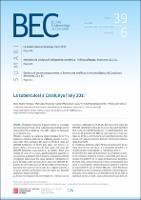La tuberculosi a Catalunya l’any 2017
Author
Date
2018-06Permanent link
https://hdl.handle.net/11351/3901ISSN
2385-720X
DL
B. 11287-2015
Abstract
Introduction. The purpose of this article is to present the preliminary results of the epidemiological surveillance of tuberculosis (TB) in Catalonia in 2017 and to assess its evolution in recent years. Methods and results. The epidemiological surveillance of TB in Catalonia combines passive and active surveillance systems. In 2017, 1,001 cases were reported (13.2 cases per 100.000 inhabitants). Sixty-one point six per cent of cases are men and 38.4% are women, with a rate of 16.6 cases and 10 cases per 100.000 inhabitants, respectively. The mean age of the patients was 44.3 years, significantly higher in native population (49.7 years) compared to immigrants (38.3 years). Pediatric cases represent 6.3% of the total, with a rate of 5.3 cases per 100.000 inhabitants. Forty-seven point seven per cent of TB cases have been immigrants who have presented an incidence rate that is more than 4 times higher than that of indigenous population (35.8 and 8.4 cases per 100.000 inhabitants, respectively). The most common form of TB has been pulmonary, observed in 69.4% of cases (9.2 cases per 100.000 inhabitants), of which 41.4% have been smear positive (3.8 cases per 100.000 inhabitants). The diagnostic delay of TB pulmonary cases in 2017 was higher than one month (median of 47 days) but has decreased significantly to that observed among the cases of 2016 (47 and 56 median days, respectively). The primary resistance to any first-line drugs has been 12.4%; to isoniazid, 6.6%, and simultaneously to isoniazid and rifampicin, 1%. In 79.3% of cases of pulmonary TB a study of contacts was conducted, a lower proportion than that of 2016, but up to 88.9% in smear positive pulmonary TB cases. Eighty-seven point two per cent of the cases of TB that began treatment in 2016 completed it satisfactorily, a higher proportion in women (88.5%) than in men (86.4%) and without significant differences between native persons and the immigrants. With respect to 2016, the TB incidence rate of 2017 has decreased by only 0.8%, due to a 3,4% decrease in indigenous people but an increase of 1.4% in immigrants, while in 2016 the reduction observed with respect to the 2015 rate was 7%. Conclusions. Despite significant advances in the control of this disease, the incidence of TB in Catalonia in 2017 shows a slowdown in the decline observed in recent years. This highlights the need to increase efforts to maintain the necessary political and technical commitment and intensifying efforts for TB control and elimination, identifying and treating cases of latent tuberculosis infection and thus, decreasing the reservoir of the causative agent of this disease.
Keywords
Tuberculosis; Epidemiological surveillance; Microbiological notificationBibliographic citation
Rodés-Monegal A, López-Espinilla M, Manzanares-Laya S, García-Lebrón M, Jané-Checa M. La tuberculosi a Catalunya l’any 2017. Butll Epidemiol Catalunya. 2018 juny;39(06):124-134.
Audience
Professionals
This item appears in following collections
- DS - Articles científics [407]
The following license files are associated with this item:

 Private area
Private area Contact Us
Contact Us







